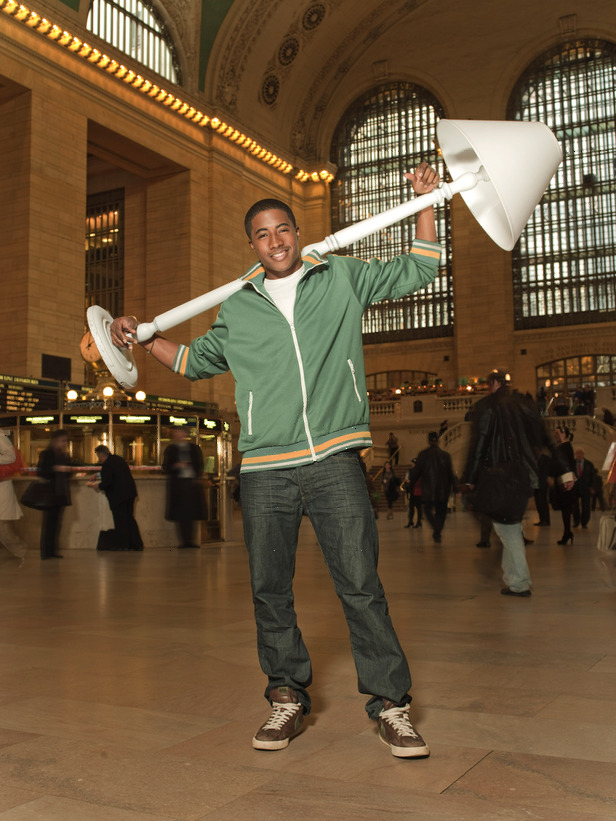
When I put together my cast critique prior to this season’s premiere of Design Star, I characterized Alex Sanchez as being “moldable,” due to his young age (26). He turned out to indeed be moldable in a positive way…but in real life, he’s doing his fair share of the molding, too.
With your Caribbean background, were you disappointed that your teammates chose the French food basket inspiration instead of the tropical basket?
Actually, the French basket was my first choice, probably because I hate going typical and expected. I think if I’d gone for the tropical food basket, that would’ve just been too expected.
What do you think is more important in this competition: showing talent for design or showing talent for spinning B.S. about your design?
I definitely believe that being very eloquent helps a lot in this season! Personally, I wish there were more individual challenges in the competition so that everyone would have a chance to show their talents. We have good designers on the show, but no one had a chance to show that.
A Twitter follower wants to know, were you as shocked as the rest of us to find out that Courtland Bascon is straight?
He spent a long time every day—every minute—talking about Dina (Pitsos). We all know Dina now, just from hearing him talk about it.
A commenter on HGTV’s Design Star blog asks, “Did you feel isolated by the other contestants throughout the show? Because that’s the way it appeared on camera.”
I did, but I went into the competition expecting it. The one person I had on my side was Tom (Vecchione). Tom was like my voice of reason. When he left, it got a little bit harder to function within the house.
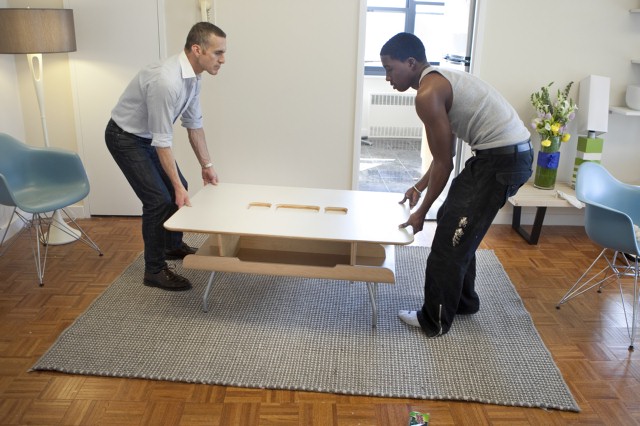
Tom and Alex load their living room during the fourth challenge.
Tom seemed like a nice guy. So y’all bonded?
Yeah, we did bond. I respected the fact that Tom was humble and able to take criticism, being as established as he is in the design field. It was his main impression to me that he was even lucky to be on the show and worked so well with people who had a lot less experience than he did.
You mentioned during one of the Design Star Twitter parties that you were “subtitled again.” I didn’t notice that until you commented on it.
I know I talk fast, but they subtitled me during three different episodes. I just thought that was hilarious.
You mentioned several times during this episode that you enjoyed learning new things. From which of your Design Star colleagues did you learn the most?
I learned a lot from Courtland, simply because I was never experienced in building. Courtland actually taught me a lot. As time went on, when we were working together, we would often talk about different things about design—things that I wasn’t too sure about, that I wanted clarification about. He had so much experience, he taught me the most out of everyone there, as far as design’s concerned. Tom taught me the most about life in general. He said you had to understand that people are going to be who they are and you have to make sure to stay true to yourself. He always encouraged me to be myself—to be the man I’m supposed to be, regardless of whether or not I’m on the show.
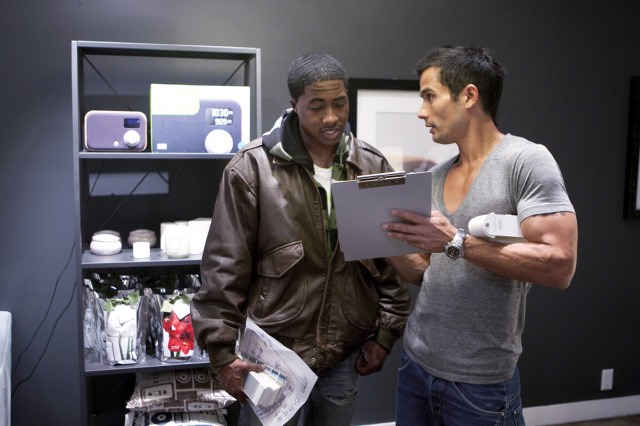
Alex picked up construction and design tips from Courtland.
You were a real standout on the hosting side of the competition. How were you able to remain relaxed and composed during such a stressful situation?
Honestly, I really have no idea! When I did the hosting for the flower challenge, I actually went into that part of the challenge extremely upset and frustrated. As soon as we finished the challenge, we went straight into the hosting. We did not have much of a break at all, in between. So we go through all that frustration, were just named in the bottom, and then just go and host. It was some kind of miracle that I was able to pull anything off that was decent and not upset. It literally was like, changing my mindset and thinking as if I’m not in the bottom two or six or whatever it was at the time.
Did you expect Michael Moeller to loosen up toward you after you saved his butt during the firehouse challenge?
No, I didn’t expect that at all. Being around Michael–even though I didn’t know all of the things he said in his interviews–I still understood how he was and how he felt about me as a person. Even though he didn’t say anything, it was pretty evident to me. I didn’t expect much coming from him.
What did you think he thought about you as a person?
From early on, I think he felt superior to me as a person…as a designer. I’m okay with people feeling that way. That’s just a part of their personality. It has nothing to do with me, so I didn’t take any offense to it. I separated it from the competition and from him as a person. We got along in the house for the most part. We just didn’t like working together.
So you thought he felt superior to you as a designer, but not as a person.
Maybe as a person too, I’m not sure. But definitely as a designer.
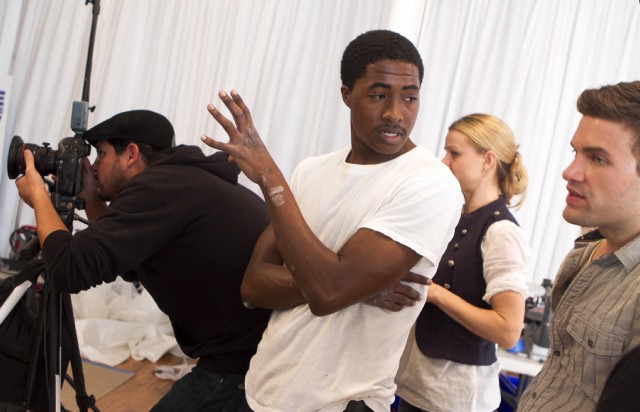
Too many cooks in the kitchen. (Literally.) The Blue Team, from left: Alex, Casey, Michael.
Do you think the other finalists underestimated you?
I know for sure that they underestimated me. It was interesting to me because in a competition like this, a lot of opinions are based on ego. If I keep boasting about all that I do and all that I have and the kind of designer that I am, you’re more inclined to believe it. We heard a lot of times when I was on the show, “I know so-and-so’s a good designer,” even though so far they haven’t been able to show any of it. People just assumed that they were, because of their years of experience and the projects that they’ve done in the past. They automatically kind of came in there with a leg up, just by saying what they’d done. I’ve never been shy about telling the truth that there’s stuff I need to learn or places I need to improve. That doesn’t make me a weak designer, it’s just realistic. We should all understand there are places we need to improve. But it means more of a weakness in a competition like this.
During the first four seasons of Design Star, the finalists were sequestered and unable to communicate with their family or friends. During last night’s episode, they showed Casey Noble talking to her husband, and we know (via Emily Henderson’s blog) that Dan Faires was given permission to speak to his mom and his girlfriend (now wife). What were the rules this season regarding contact with the outside world? Were you able to speak to anyone?
I actually didn’t get to speak to anyone. The rule, as I understood it, was that we were supposed to be sequestered for the most part, but as long as we didn’t talk about the show, we could talk to a few people, based on approval. (Weird, because Casey told her husband she was in the final four.) I personally didn’t want to talk to anyone when I was on the show because I wanted to be focused on being there and I didn’t want to get distracted by anything else that might be going on at home. I didn’t actually try to get approval to talk to anyone.
You do a lot of mentoring work. Can you tell me about that?
I had a lot of people supporting me as I was growing up, so I try my best to reciprocate that–especially here in DC, where a lot of people don’t have father figures. I just worked on a program with the Leadership Development Institute in Baltimore last month. They bring boys from all over the East coast and we teach them how to be men—how to move forward. They’re high school students who are about to go to college. The great thing is that the show has given me a greater voice. These same kids I talked to last year, they were like, “Okay, yeah, I know,” but they just kind of heard me. This year, I could’ve said anything and they listened so much more intently, knowing that I’ve been on TV. It’s amazing, the kind of influence you have, just by being on television. I’m just using that as much as possible, doing a lot of speaking engagements. It’s an amazing opportunity for mentorship and to get more kids into the arts—actually pushing them to do great things. I’m really happy about that result of doing the show.
Did you have mentors as a young person?
I had a few. My parents were very, very involved in my life. I also had a lot of coaches—my coaches have been like my big brothers and my second fathers. They always made sure that I did right. I grew up in a rough neighborhood and no one let me hang out in that neighborhood. I don’t care what it was, they kept me busy all the time—they did not want me hanging around that neighborhood. I appreciate them for that. Everyone kind of looked out for me when I was growing up.
How has your island upbringing—that part of your childhood—affected you as a designer?
It helps me stay relaxed-minded about things. We’re not into anything rigid–everything’s very, very fluid. Everything changes by the second. No one is stuck to one thing. It keeps me reinventing myself, keeping me more relaxed in general. Growing up in that type of atmosphere also gives me a different perspective on color, on layout, and just lifestyle in general. People like to express themselves through color and step outside the box. I appreciate that.
You mentioned in another interview that you never intended to become an interior designer. What did you think you would be instead?
I always thought I’d be an architect—which I will still be, because I’m going back for my master’s next year. The funny thing is, I ran home every day to watch design shows. I wanted to watch Christopher Lowell and Hometime building shows. I was always trying to redesign my house and drew up plans for the renovation when I was, like, twelve. It was something I thought a lot of people did—I didn’t realize it was different. I never thought it’d be a career, I just knew I loved doing it.
Why do you call yourself “The Renaissance?”
I wanted to make a living off of all the things I love doing in the arts. Here in DC, after I left my corporate job, I was finding my own niche and figuring out what I really wanted to do. I did anything that would make me some kind of money, so I was doing art, I was doing modeling, I was taking pictures, I was doing design work. I did everything I could do in the arts to make ends meet. Then I realized, why can’t that be my career? Why can’t I live like that? I don’t want to get stagnant. I don’t want to do the same thing every day. So every day is different to me—luckily. Alex’s DC interior design and photography business is called Renaissance Design.
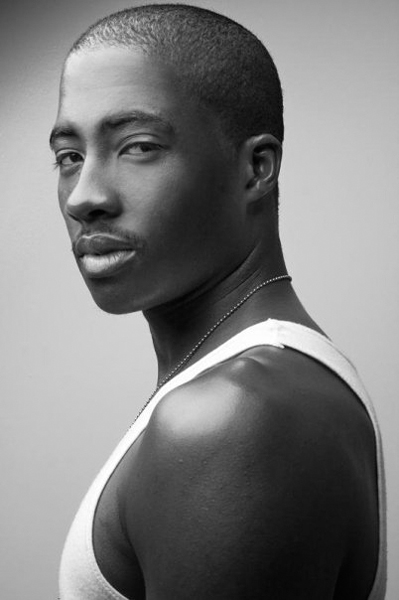
SMOKIN' HOT. Photo courtesy of Tarrice Love Photography.
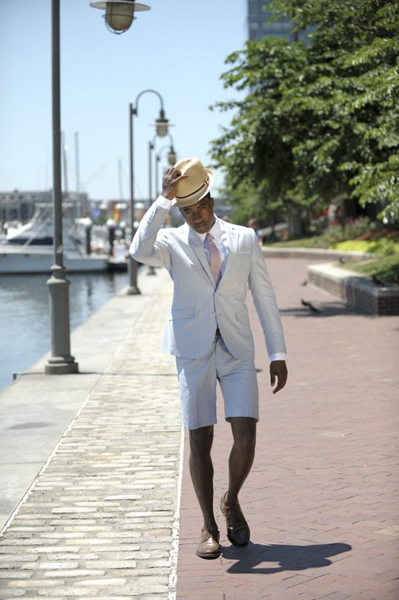
More modeling work. Photo courtesy of Young Gentlemen Society, LLC.
Are you currently seeing anyone?
I am extremely single! I’m married to my work, but I’m trying to fix that! I’ve decided in August, I’ll at least start dating! I don’t have a chance to go out much. (Admirers of Alex, it’s now August!)
What are you working on now?
I do a lot of renovations here in the DC area, working with a brokerage. My main goal is to redesign and redevelop a couple of city blocks. I want to be able to change the feel of what would be considered a bad neighborhood and redesign it so there’s a lot more appeal without changing the demographics of the people who live there. I’ve been working in Southeast and Northeast DC, renovating houses there in previously bad neighborhoods. The thing is, I have to keep within a certain budget to make it profitable for the brokerage–because it’s about the bottom line–but still make it look like it cost ten times what it does. That challenge has been great for me because I’ve been talking about this for years, just trying to figure out how I’d be able to change neighborhoods without making it look like a factory, so people can afford to live there. It was great to put my thing into practice. They’re really hot—I’m actually really, really proud of them.

BEFORE & AFTER. Alex renovated this row house in the Trinidad neighborhood of NE Washington, DC.
I think it’s great that your focus is not to change the demographics—that’s a big deal.
What I’ve discovered is, the way you renovate affects the way people treat the neighborhood. If you go to a bad neighborhood, you might find one trash can for every two blocks, whereas in a nice neighborhood, you might find three on one block. So the worst neighborhoods are naturally dirtier because there’s no place for you to put anything. You usually don’t have as many lights in bad neighborhoods as you do in better neighborhoods, so it invites a different element. People don’t feel secure hanging out in unlit areas at night. If you keep it well-lit, it makes a difference. Helping people to have pride in their neighborhoods—it’s been great. We have neighbors coming up to us, thanking us for the work that we did on some of their houses. People on the block start renovating after what we’ve done, so we’ve inspired change already and we just got started.
So you’re doing your own Curb Appeal: The Block!
I am! But I’ve always had big plans for architecture and design, so I’m working 24/7 to try and make it happen.
The fifth season of Design Star airs Sundays at 9pm CST on HGTV. Unless otherwise noted, all photos courtesy of HGTV.

Super guy! Doing quite a lot at a young age. He looks to have a bright future ahead.
What he’s doing is so great. I lived in NE DC for seven years (went to college and grad school there) and it’s been getting better every year. It’s great to see a face behind that progress!
Wow! I always got the sense watching the show that Alex was a good guy, but it was hard to get a handle on who he was (I haven’t looked at any of the profiles, etc. on the official page, which might help!). It’s really awesome to see someone so young and talented with humility, modesty and a willingness to be open to new ideas.
It’s kind of unfortunate that decency and kindness isn’t more of a factor on DS, although that would be really hard to judge. It’s just…it doesn’t matter how talented you are if you’re an asshole who makes the people around you feel miserable. Why deal with a talented jerk when you could hire someone like Alex, who can give you a beautifully designed space AND make you feel good at the same time?
Alex is really a classy guy. Very motivated and respectful. You can tell he is very humble. I don’t no if I could have been as gracious abut Michael as he was. That’s the mark of a truly good person. I have a feeling he will be rewarded for it. If HGTV did not do anything else right, I will at least give them credit for bringing this bright and talented individual forth to begin with.
I think we’ll be seeing more of this young gentleman! I hope wonderful tihngs come to him as a result of his time on DS.
He sure is doing a lot for being so young – I like his attitude and I like that he was honest about what he thought about how design star is progressing this year – more individual challenges please.
My! what a beautiful interview. I am so proud of Alex. I am so glad to know that he is giving back(as a young man) some of the good thing that were given to him as a youth. Keep up the good works Alex. We are praying for you. Keep your eyes on your goals. Don’t let anyone, or anything, bring you down.
The best of luck to you Alex! We were super proud of you and you were indeed the best designer on the show. Just read the blogs, everyone was rooting for you. But you got your name out there, and that counts for a lot. So great to read that you are doing things for your community. We need more young men like you. Good luck, we are sure we have not heard the last of you!
Alex, my wife is really into HGTV so I watched Design Star with great enthusiasm because you were representin for the Brothers and A PHI A no doubt! I must say that you represented yourself and your family very well bro and I know the best is yet to come. I am still looking for you to hook up my man cave in the basement bruh! Much respect, J²
Alex was my favorite designer, and I always figured he was a good guy, but wow. What a wonderful man! Level-headed, logical, proactive and introspective. PLUS he gives to his community! Doesn’t get much better than that. No wonder Michael was so threatened by you!
Good work, Alex! Best wishes!
Several years ago, Alex Sanchez worked as my design assistant. Alex spent four months by my side and watched me take command of many Washington, DC projects. Alex is a kind, honest and gentle individual. I see only good things in his future.
Alex seemed like an awesome person and I’m glad he was able to use the platform of the show to help others. That he is so gracious about Michael is also very telling. It’s funny that he talks so glowingly about Tom because Tom also struck me as a solid, decent individual. I’m glad he could learn so much from Tom and Courtland and I wish him the best in the future. It sounds like the future is indeed bright.